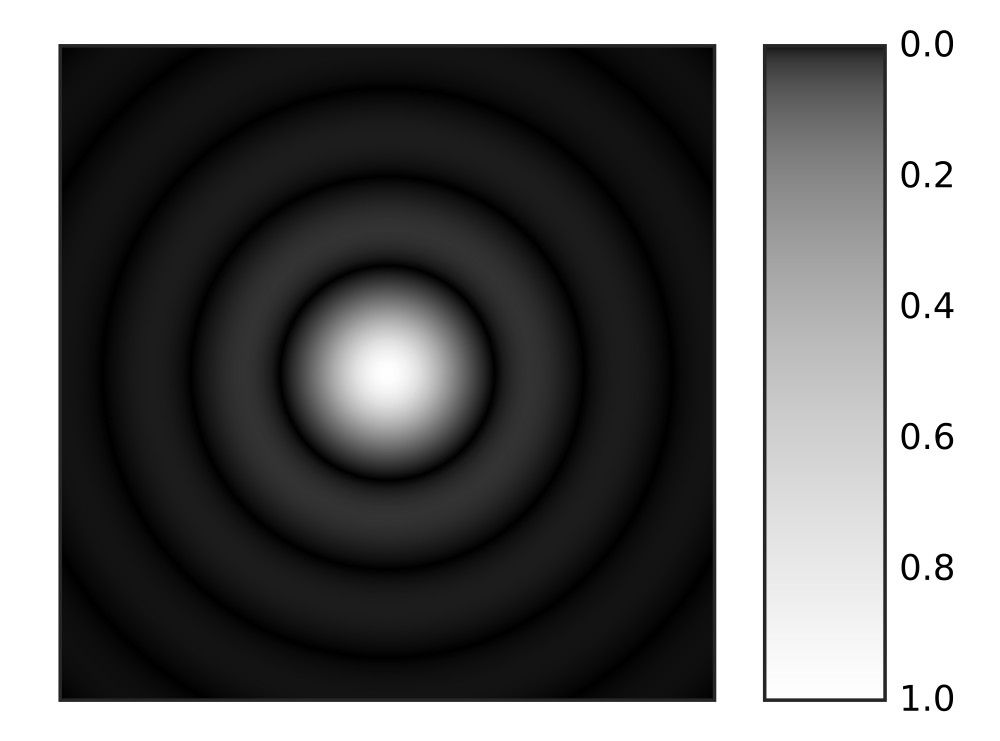
Caption: A simulated Airy diffraction pattern with intensity in grayscale.
Features:
-
An Airy diffraction pattern is
the diffraction pattern of a
plane waves impinging
on a circular aperture in a screen that is
parallel to the wave fronts.
- The setup enforces circular symmetry about the axis that is perpendicular to the screen
and passes through the center.
This axis can be considered the optical axis
of the system.
- The source in most astronomical application is
a point light source
at optical infinity.
- The Airy diffraction pattern
consists of a bright central diffraction fringe
surrounded by concentric alternating
dark and bright fringes which
are called Airy rings.
- To digress, why don't we notice
the Airy diffraction pattern
and other diffraction patterns
for light in
everyday life?
- First note that diffraction
is an effect of
physical optics.
Geometrical optics
is the limit of physical optics
in which light
can be treated as light rays
neglecting light's
wave nature.
- Part of the answer to the question is that
diffraction patterns
are partially averaged away by overlapping effects.
There are usually multiple
light beams giving
overlapping diffraction patterns.
Also diffraction
is wavelength-dependent.
Thus, polychromatic light
gives rise to overlapping and partially canceling
diffraction patterns.
-
However, even for
a single light beam of
monochromatic light,
diffraction is often
not noticeable.
- As aforementioned, diffraction
is wavelength-dependent.
If λ << L (where L is the characteristic length of the aperture or obstacle that cuts the wavefronts), then the diffraction pattern alternating dark and bright fringes are very tiny about the bright central fringe which approximates an ideal beam of light rays.
- In the ideal limit as λ/L → 0, you just have no
diffraction.
This is geometrical optics limit where
light is treated as consisting of
light rays.
- Since we are never in the ideal limit of
of geometrical optics exactly,
the dark and bright fringes
are present just at the edge of
shadows if not washed out which they often are.
- A shadow is where
the overall diffraction pattern
intensity
has asymptotically gone to zero.
- Now visible band (fiducial range 0.4--0.7 μm)
has wavelengths
much smaller than most everyday apertures
and obstacles that we notice.
So the diffraction patterns at the edges of shadows are usually too minute to be observed by casual observation.
But actually, we'd notice them pretty often if they weren't generally partially averaged away as discussed above.
- Diffraction
can be readily seen using intense
monochromatic light from
a laser
and small apertures
or obstacles.
- For more elucidation, see the
Light Diffraction
videos:
- Young's Double Slit Experiment Well Jack Maxwell (the great, great, great grandson of Jim Maxwell) never uses slits, but it's still pretty nifty what you can do with laser pointer and some pencil leads. Actually, I think Jack M is relying on Babinet's principle: "the diffraction pattern from an opaque body is identical to that from a hole of the same size and shape except for the overall forward beam intensity." He doesn't seem to know this. So his single slit acts as a double slit and his double slit acts as triple slit.
- Diffraction of Light A tutorial, not a quick show. Too long for the classroom.
- First note that diffraction
is an effect of
physical optics.
Geometrical optics
is the limit of physical optics
in which light
can be treated as light rays
neglecting light's
wave nature.
- Let us now return to
the Airy diffraction pattern after
our bracing digression into generality.
- The Airy diffraction pattern
is only readily noticeable
when light
wavelength λ is comparable to or
greater than the aperture
diameter D.
- As λ grows smaller than D, the
Airy rings
become very narrow and
asymptotically vanish
leaving only shadow
and the bright central
Airy disk.
- In this case the characteristic length scale of the aperture
is the diameter D.
Thus, in the limit of λ/D → 0, you just have
geometrical optics.
Image link: Wikipedia.
Local file: local link: optics_airy_disk.html.
File: Optics file: optics_airy_disk.html.